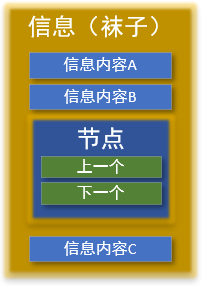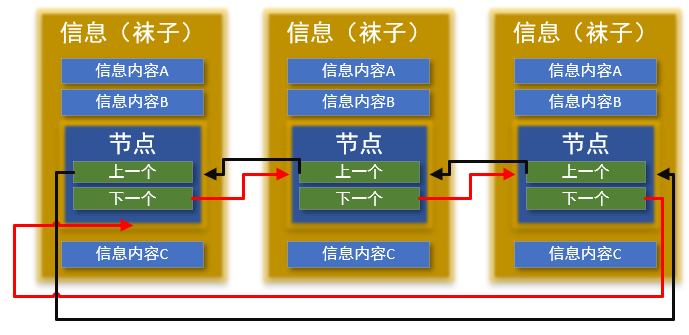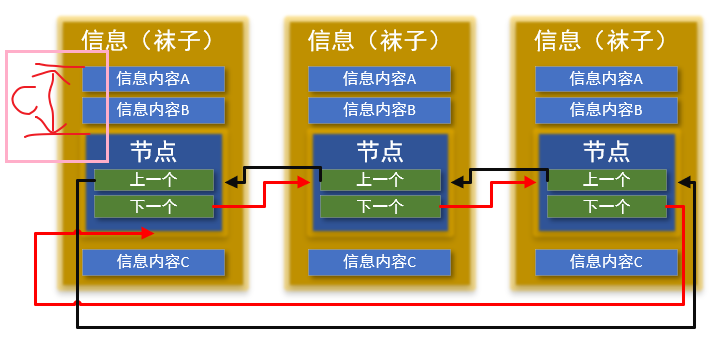連結串列-雙向通用連結串列
阿新 • • 發佈:2020-10-16
[toc]
---
## 前言
* 20201014
* 在閱讀 RTOS LiteOS 核心原始碼時發現該核心使用的連結串列是**通用連結串列**,而 FreeRTOS 核心使用的是**非通用連結串列**,所以,有必要記錄一下關於連結串列實現的筆記。
* 以下內容為個人筆記,涉及一些非官方詞彙,敬請諒解,謝謝。
## 概念
* 正常表達
* 連結串列:
* 連結串列為 C 中一種基礎的資料結構。
* 看成環形晾衣架即可。
* 節點:
* 節點組成連結串列
* **非通用連結串列**自理解概念:**節點攜帶資訊**
* 連結串列:圓形的晾衣架
* 節點:掛鉤
* 包含上一個
* 下一個
* 鉤子等其它需要的資訊
* 襪子:掛在到 **鉤子** 的東西
* 包含**被鉤子**
* 襪子攜帶的資訊
* **通用連結串列**自理解概念:**資訊攜帶節點**
* 連結串列:圓形的晾衣架
* 節點:晾衣架圓形框的一截
* 僅包含上一個
* 下一個
* 襪子:擺到晾衣架圓形框的一截上,使得節點成為襪子的一個成員指標變數
* 襪子攜帶的資訊
* 資訊中包含**節點**
* **通用連結串列與非通用連結串列的區別**
* 通用連結串列節點內容很少一般只有 **上一個** 和 **下一個**。
* 通用連結串列節點被放到資訊結構體中,通過偏移找到所在的結構體(即是通過偏移找到襪子頭)
* 而非通用連結串列是在節點中攜帶資訊結構體的指標的(即是節點就攜帶資訊)。
* ***別人通俗理解,讀者不必理會本小點***
* 通用連結串列是把襪子放到晾衣架的圓形圈上,襪子與圓形圈接觸部分為襪子接待的節點。(***資訊攜帶節點***)
* 非通用連結串列是。(***節點攜帶資訊***)
* 通用連結串列的 **鏈-線** 穿插於襪子中(***襪子即是資訊***)
* 非通用連結串列的 **鏈-線** 連在鉤子,再由鉤子鉤襪子
## 筆錄草稿
## 雙向連結串列
* 雙向連結串列理解圖

### 節點、連結串列及資訊訪問 **
* **節點**
* 成員僅有是一個和下一個

```c
/*
*Structure of a node in a doubly linked list.
*/
typedef struct LSS_LIST
{
struct LSS_LIST *pstPrev; /**< Current node's pointer to the previous node*/
struct LSS_LIST *pstNext; /**< Current node's pointer to the next node*/
} LSS_LIST;
typedef struct LSS_LIST listItem_t;
```
* **連結串列**
* 多個**節點**組成**連結串列**

* **資訊訪問**
* **操作通用連結串列的最核心、最重要部分是通過偏移獲得資訊控制代碼**(*襪子頭*)
* 如下圖 **C** 中的長度就是節點與資訊控制代碼的偏移長度,只需知道 **節點地址、資訊型別(結構體型別)及成員名字(即是當前節點在結構體中的成員名字)**即可獲得資訊控制代碼

```c
/*
* @param item Current node's pointer.
* @param type Structure name of type.
* @param member Member name of the doubly linked list in the structure.
*/
#define LSS_LIST_ENTRY(item, type, member) \
((type *)((char *)(item) - (unsigned long)(&((type *)0)->member)))
```
### 操作程式碼及闡述
* 以下只是通用連結串列的一些擴充套件例子,更多的可以自己象限+實現。
#### 1. 初始化連結串列
* 上一個指向自己
* 下一個指向自己
```c
/**
* @brief 連結串列初始化
* @param pstList:需要初始化的連結串列(節點)指標
* @retval none
* @author lzm
*/
void listInit(listItem_t *pstList)
{
pstList->pstNext = pstList;
pstList->pstPrev = pstList;
}
```
#### 2. 獲取第一個節點
* 指向當前節點的下一個節點
* *第一個即是下一個*
```c
/**
* @brief 獲取第一個節點
* @param pstObject:當前節點指標
* @retval none
* @author lzm
*/
#define listGetFirst(pstObject) ((pstObject)->
